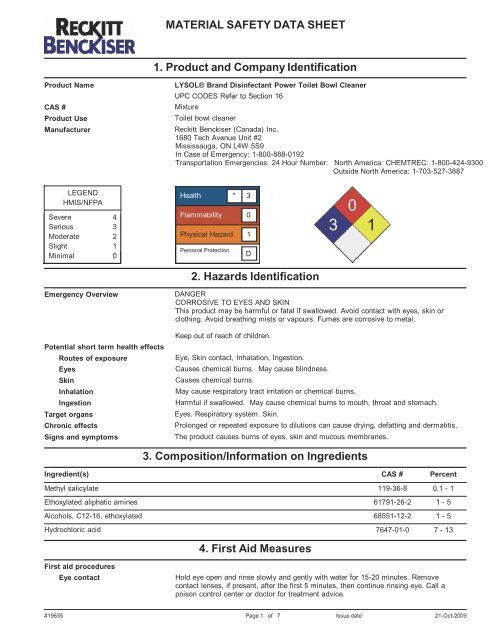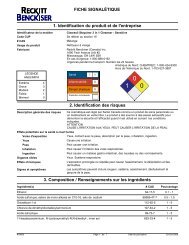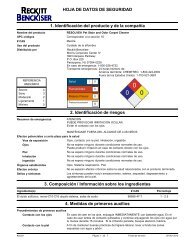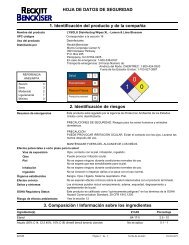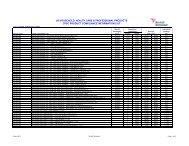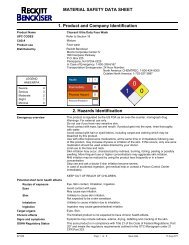LYSOL Brand Disinfectant Power Toilet Bowl ... - Reckitt Benckiser
LYSOL Brand Disinfectant Power Toilet Bowl ... - Reckitt Benckiser
LYSOL Brand Disinfectant Power Toilet Bowl ... - Reckitt Benckiser
- No tags were found...
Create successful ePaper yourself
Turn your PDF publications into a flip-book with our unique Google optimized e-Paper software.
....MATERIAL SAFETY DATA SHEET1. Product and Company IdentificationspaceProduct NamespacespaceCAS #spaceProduct UsespaceManufacturer<strong>LYSOL</strong>® <strong>Brand</strong> <strong>Disinfectant</strong> <strong>Power</strong> <strong>Toilet</strong> <strong>Bowl</strong> CleanerUPC CODES Refer to Section 16Mixture<strong>Toilet</strong> bowl cleaner<strong>Reckitt</strong> <strong>Benckiser</strong> (Canada) Inc.1680 Tech Avenue Unit #2Mississauga, ON L4W 5S9In Case of Emergency: 1-800-888-0192Transportation Emergencies: 24 Hour Number: North America: CHEMTREC: 1-800-424-9300Outside North America: 1-703-527-3887spaceLEGENDHMIS/NFPASevereSerious43Moderate 2Slight 1Minimal 0Health * 3Flammability 0Physical Hazard 1Personal ProtectionD2. Hazards Identification03 1spaceEmergency OverviewspacePotential short term health effectsRoutes of exposurespaceEyesspaceSkinspaceInhalationspaceIngestionspaceTarget organsspaceChronic effectsspaceSigns and symptomsDANGERCORROSIVE TO EYES AND SKINThis product may be harmful or fatal if swallowed. Avoid contact with eyes, skin orclothing. Avoid breathing mists or vapours. Fumes are corrosive to metal.Keep out of reach of children.Eye, Skin contact, Inhalation, Ingestion.Causes chemical burns. May cause blindness.Causes chemical burns.May cause respiratory tract irritation or chemical burns.Harmful if swallowed. May cause chemical burns to mouth, throat and stomach.Eyes. Respiratory system. Skin.Prolonged or repeated exposure to dilutions can cause drying, defatting and dermatitis.The product causes burns of eyes, skin and mucous membranes.3. Composition/Information on IngredientsspaceIngredient(s)Methyl salicylateEthoxylated aliphatic aminesAlcohols, C12-16, ethoxylatedHydrochloric acidCAS #119-36-861791-26-268551-12-27647-01-0Percent0.1 - 11 - 51 - 57 - 13spaceFirst aid proceduresEye contact4. First Aid MeasuresHold eye open and rinse slowly and gently with water for 15-20 minutes. Removecontact lenses, if present, after the first 5 minutes, then continue rinsing eye. Call apoison control center or doctor for treatment advice.#19635 Page 1 of 7 Issue date 21-Oct-2009
...spacespacespacespaceSkin contactInhalationIngestionNotes to physicianspaceGeneral adviceImmediately flush with cool water for 20 minutes while removing contaminated clothingand shoes. Discard or wash well before reuse. Obtain medical attention if irritationpersists.If symptoms develop move victim to fresh air. If symptoms persist, obtain medicalattention.Do not induce vomiting. If vomiting occurs naturally, have victim lean forward to reducerisk of aspiration. Never give anything by mouth if victim is unconscious, or isconvulsing. Obtain medical attention.If the product is ingested, probable mucosal damage may contraindicate the use ofgastric lavage. Treat the affected person appropriately. Symptoms may be delayed.If you feel unwell, seek medical advice (show the label where possible). Ensure thatmedical personnel are aware of the material(s) involved, and take precautions to protectthemselves. Show this safety data sheet to the doctor in attendance. Avoid contact witheyes and skin. Keep out of reach of children.5. Fire-fighting MeasuresspaceFlammable propertiesspaceExtinguishing mediaspaceSuitable extinguishing mediaUnsuitable extinguishing media Not availablespaceProtection of firefightersSpecific hazards arising from Not availablethe chemicalspaceProtective equipment forfirefighersspaceHazardous combustion productsspaceExplosion dataspaceSensitivity to mechanicalimpactSensitivity to static dischargeNot flammable by WHMIS criteria.Dry chemical. Water spray. Foam.Firefighters should wear full protective clothing including self contained breathingapparatus.May include and are not limited to: Hydrogen chloride. Oxides of carbon.Not availableNot available6. Accidental Release MeasuresspacePersonal precautionsspaceMethods for containmentspaceMethods for cleaning upspaceHandlingspaceStorageKeep unnecessary personnel away. Do not touch or walk through spilled material. Donot touch damaged containers or spilled material unless wearing appropriate protectiveclothing. Keep people away from and upwind of spill/leak.Stop leak if you can do so without risk. Prevent entry into waterways, sewers,basements or confined areas.Before attempting clean up, refer to hazard data given above. Small spills may beabsorbed with non-reactive absorbent and placed in suitable, covered, labelledcontainers. Prevent large spills from entering sewers or waterways. Contact emergencyservices and supplier for advice. Never return spills in original containers for re-use.Large Spills: Wet down with water and dike for later disposal. After removal flushcontaminated area thoroughly with water.7. Handling and StorageUse good industrial hygiene practices in handling this material. Do not get this materialin your eyes, on your skin, or on your clothing.Keep out of the reach of children.Store in a closed container away from incompatiblematerials.#19635 Page 2 of 7 Issue date 21-Oct-2009
..spaceExposure limit valuesIngredient(s)8. Exposure Controls / Personal ProtectionExposure limit valuesAlcohols, C12-16, ethoxylatedEthoxylated aliphatic aminesHydrochloric acidACGIH-TLVNot establishedACGIH-TLVNot establishedACGIH-TLVCeiling: 2 ppmMethyl salicylatespaceEngineering controlsspacePersonal protective equipmentspacespacespacespacespaceEye/Face protectionHand protectionSkin and body protectionACGIH-TLVNot establishedGeneral ventilation normally adequate.Wear chemical goggles.Emergency responders should wear full eye and face protection.Rubber gloves. Confirm with a reputable supplier first.Emergency responders should wear impermeable gloves.Emergency responders should wear impermeable clothing and footwear whenresponding to a situation where contact with the liquid is possible.Respiratory protectionWhere exposure guideline levels may be exceeded, use an approved NIOSH respirator.Emergency responders should wear self-contained breathing apparatus (SCBA) to avoidinhalation of vapours generated by this product during a spill or other clean-upoperations.General hygiene considerations Handle in accordance with good industrial hygiene and safety practice. When using donot eat or drink. Wash hands before breaks and immediately after handling the product.AppearancespaceColourspaceFormspaceOdourspaceOdour thresholdspacePhysical statespacepHspaceFreezing pointspaceBoiling pointspacePour pointspaceFlash pointspace9. Physical and Chemical PropertiesClear.BlueLiquidWintergreenNot availableLiquid< 1 (Acidic)Not availableNot availableNot availableEvaporation RateNot availablespaceFlammability limits in air, lower, % Not availableby volumespaceFlammability Limits in Air, Upper, % Not availableby VolumespaceVapour pressurespaceVapour densityspaceSpecific gravityspaceOctanol/water coefficientspaceSolubility (H2O)spaceAuto-ignition temperaturespaceViscosity> 93.33 °C (> 200 °F) TagliabueNot availableNot availableNot availableNot availableCompleteNot availableViscous#19635 Page 3 of 7 Issue date 21-Oct-2009
...10. Stability and ReactivityspaceChemical stabilityspaceConditions to avoidspaceIncompatible materialsStable under recommended storage conditions.Do not mix with other chemicals.Reacts violently with alkaline material. This product may react with reducing agents.Fumes are corrosive to metal.Bases. Reducing agents.spaceHazardous decomposition products May include and are not limited to:spacePossibility of hazardous reactions Hazardous polymerisation does not occur.11. Toxicological InformationspaceAcute effectsspaceComponent analysis - LC50Ingredient(s)Alcohols, C12-16, ethoxylatedEthoxylated aliphatic aminesHydrochloric acidMethyl salicylatespaceComponent analysis - Oral LD50Ingredient(s)Acute LD50: 1350 mg/kg, rat, OralAcute LD50: 2000 mg/kg, rabbit, DermalLC50Not availableNot available935 ppm mouse; 3124 mg/l/4h ratNot availableLD50Alcohols, C12-16, ethoxylatedEthoxylated aliphatic aminesHydrochloric acidMethyl salicylatespaceEffects of acute exposurespaceEyeSkinspaceInhalationspaceIngestionspaceSensitisationspaceChronic effectsspaceCarcinogenicity1380 mg/kg rat620 mg/kg rat900 mg/kg rabbit; 700 mg/kg rat887 mg/kg rat; 1110 mg/kg mouse; 2100 mg/kg dog; 1300 mg/kgrabbit; 700 mg/kg guinea pigCauses chemical burns. May cause blindness.Causes chemical burns.May cause respiratory tract irritation or chemical burns.Harmful if swallowed. May cause chemical burns to mouth, throat and stomach.The finished product is not expected to have chronic health effects.The finished product is not expected to have chronic health effects.The finished product is not expected to have chronic health effects.ACGIH - Threshold Limit Values - CarcinogensHydrochloric acid 7647-01-0 A4 - Not Classifiable as a Human CarcinogenIARC - Group 3 (Not Classifiable)Hydrochloric acid 7647-01-0 Monograph 54 [1992]spaceMutagenicityThe finished product is not expected to have chronic health effects.spaceReproductive effectsspaceTeratogenicityspaceSynergistic MaterialsspaceEcotoxicityEcotoxicity - Freshwater Fish Species DataThe finished product is not expected to have chronic health effects.The finished product is not expected to have chronic health effects.Not available12. Ecological InformationBulk quantities, if spilled, may be toxic to aquatic organisms, fish, birds and mammals.control and clean up all exterior spills and prevent liquid from entering any streams,rivers, lakes and all other bodies of water.Hydrochloric acid7647-01-0 96 Hr LC50 Gambusia affinis: 282 mg/L [static]Ecotoxicity - Microtox DataMethyl salicylate119-36-8 1 Hr EC50 Bacillus subtilis: 989 mg/L; 16 Hr EC50 Pseudomonas putida: 380 mg/LEcotoxicity - Water Flea DataMethyl salicylate 119-36-8 24 Hr EC50 Daphnia magna: 50 mg/L#19635 Page 4 of 7 Issue date 21-Oct-2009
..spaceEnvironmental effectsspaceAquatic toxicityspacePersistence and degradabilityspaceBioaccumulation/accumulationspacePartition coefficientspaceMobility in environmental mediaspaceChemical fate informationspaceOther adverse effectsNot availableNot availableNot availableNot availableNot availableNot availableNot availableNot available13. Disposal ConsiderationsspaceWaste codesspaceDisposal instructionsspaceWaste from residues / unusedproductsspaceContaminated packagingNot availableDispose in accordance with all applicable regulations.Not availableNot available14. Transport InformationspaceU.S. Department of Transportation (DOT)UN 1789, Hydrochloric Acid Solution, Class 8, PG II,Re-Classed as Consumer Commodity ORM-DspaceTransportation of Dangerous Goods (TDG - Canada)UN 1789, Hydrochloric Acid Solution, Class 8, PG II,Re-Classed as Consumer Commodity / Limited Quantity#19635 Page 5 of 7 Issue date 21-Oct-2009
..spaceIMDG (Marine Transport)UN 1789, Hydrochloric Acid Solution, Class 8, PG II, Limited QuantityspaceIATA/ICAO (Air)UN 1789 - Hydrochloric Acid solution, Class 8, PG II15. Regulatory InformationspaceCanadian federal regulationsThis product has been classified in accordance with the hazard criteria of the ControlledProducts Regulations and the MSDS contains all the information required by theControlled Products Regulations.spaceCanada - WHMIS - Ingredient Disclosure ListHydrochloric acid 7647-01-0 1 %Methyl salicylate 119-36-8 0.1 %spaceWHMIS classification Exempt - Registered product - (DIN 02275465)Inventory StatusCountry(s) or regionCanadaCanadaInventory NameDomestic Substances List (DSL)Non-Domestic Substances List (NDSL)On Inventory (Yes/No)*YesNoA "Yes" indicates that all components of this product comply with the inventory requirements administered by the governingcountry(s)16. Other InformationspaceDisclaimerspaceThis product should only be used as directed on the label and for the purpose intended.To the best of our knowledge, the information contained herein is accurate. However,neither the above named supplier nor any of its subsidiaries assumes any liabilitywhatsoever for the accuracy or completeness of the information contained herein. Finaldetermination of suitability of any material is the sole responsibility of the user. Allmaterials may present unknown hazards and should be used with caution. Althoughcertain hazards are described herein, we cannot guarantee that these are the onlyhazards that exist.Recommended useIt is a violation of Federal law to use this product in a manner inconsistent with itslabeling.#19635 Page 6 of 7 Issue date 21-Oct-2009
spaceFurther information 59631-50814-<strong>LYSOL</strong>® <strong>Brand</strong> <strong>Disinfectant</strong> <strong>Power</strong> <strong>Toilet</strong> <strong>Bowl</strong> Cleaner -1LFORMULA NUMBER 353846DIN 02275465spaceIssue datespaceEffective Datespace59631-34092-<strong>LYSOL</strong>® <strong>Brand</strong> <strong>Disinfectant</strong> <strong>Power</strong> <strong>Toilet</strong> <strong>Bowl</strong> Cleaner -710mLFORMULA NUMBER 353846DIN 0227546521-Oct-200915-Oct-2009Expiry Date15-Oct-2012spacePrepared by <strong>Reckitt</strong> <strong>Benckiser</strong> Regulatory Department 800-333-3899spaceOther InformationFor an updated MSDS, please contact the supplier/manufacturer listed on the firstpage of the document.#19635 Page 7 of 7 Issue date 21-Oct-2009


